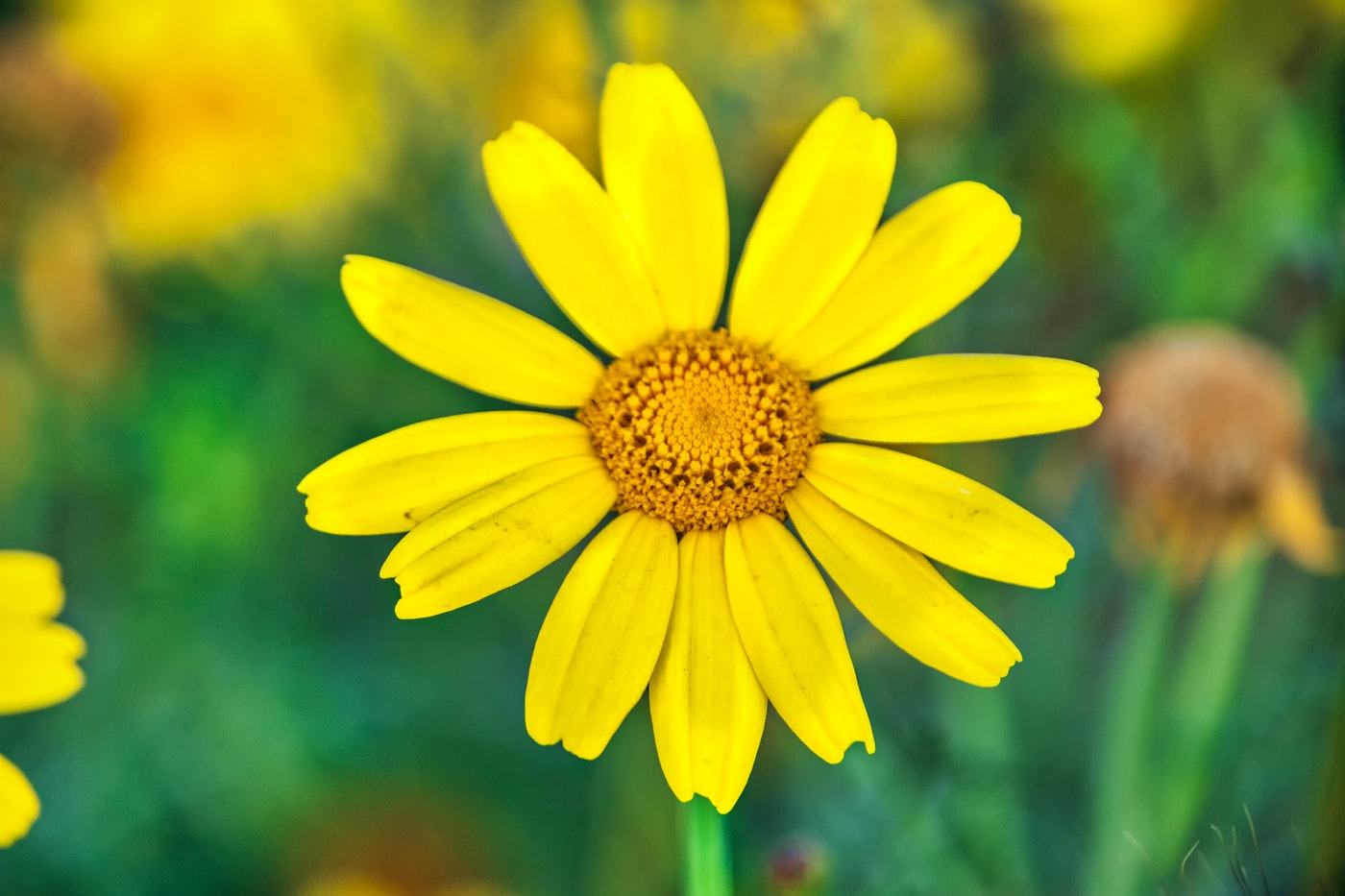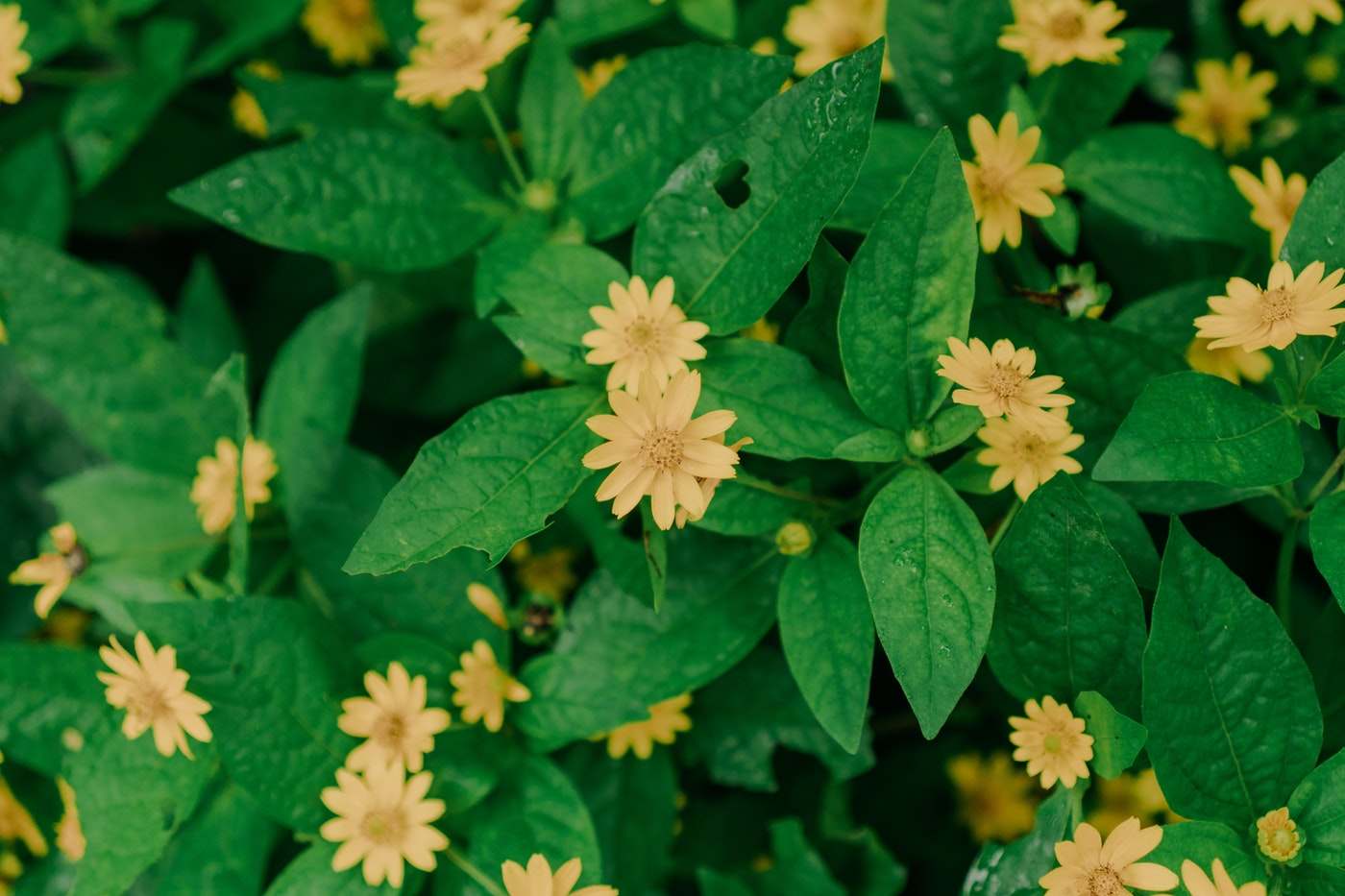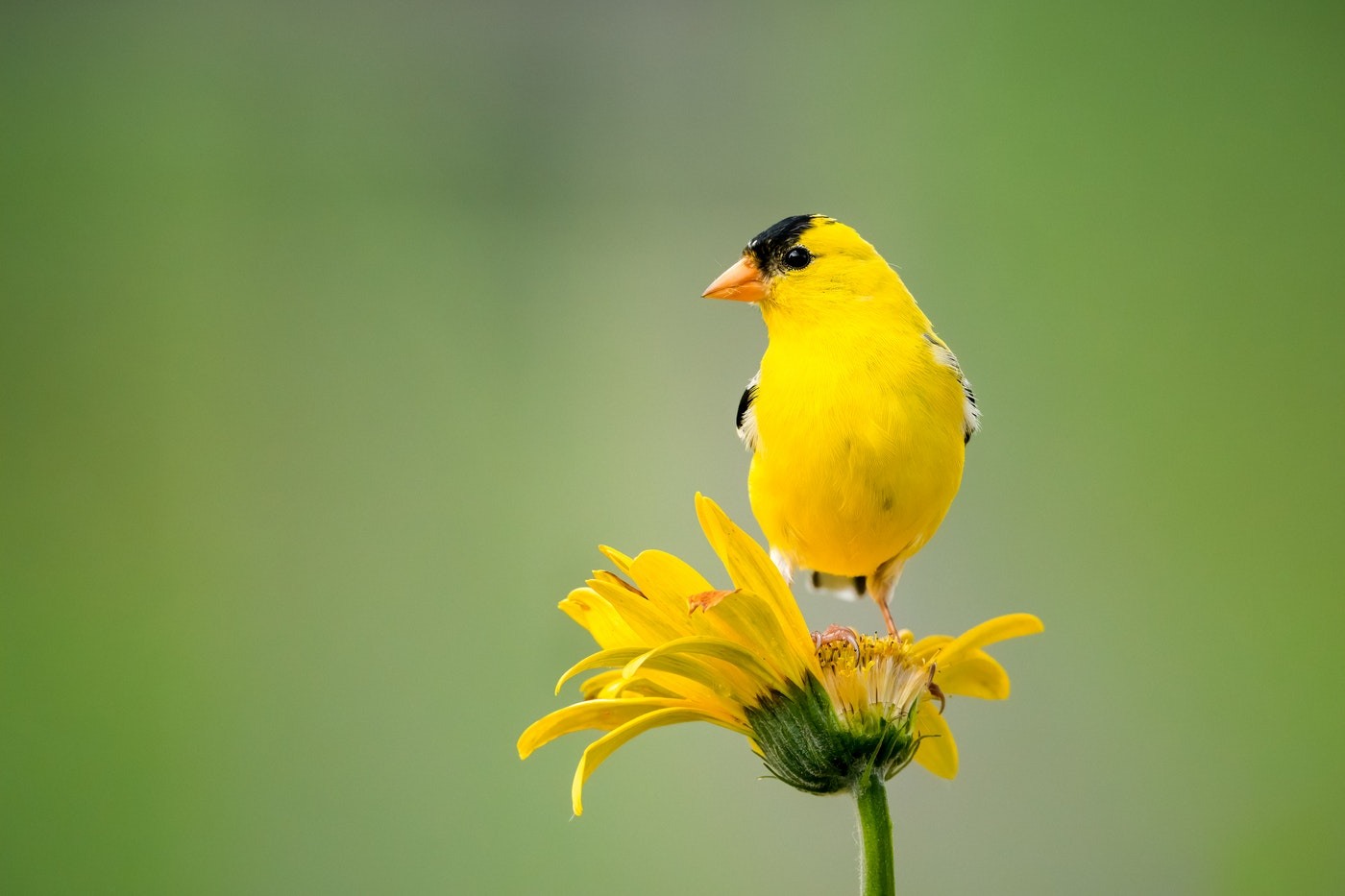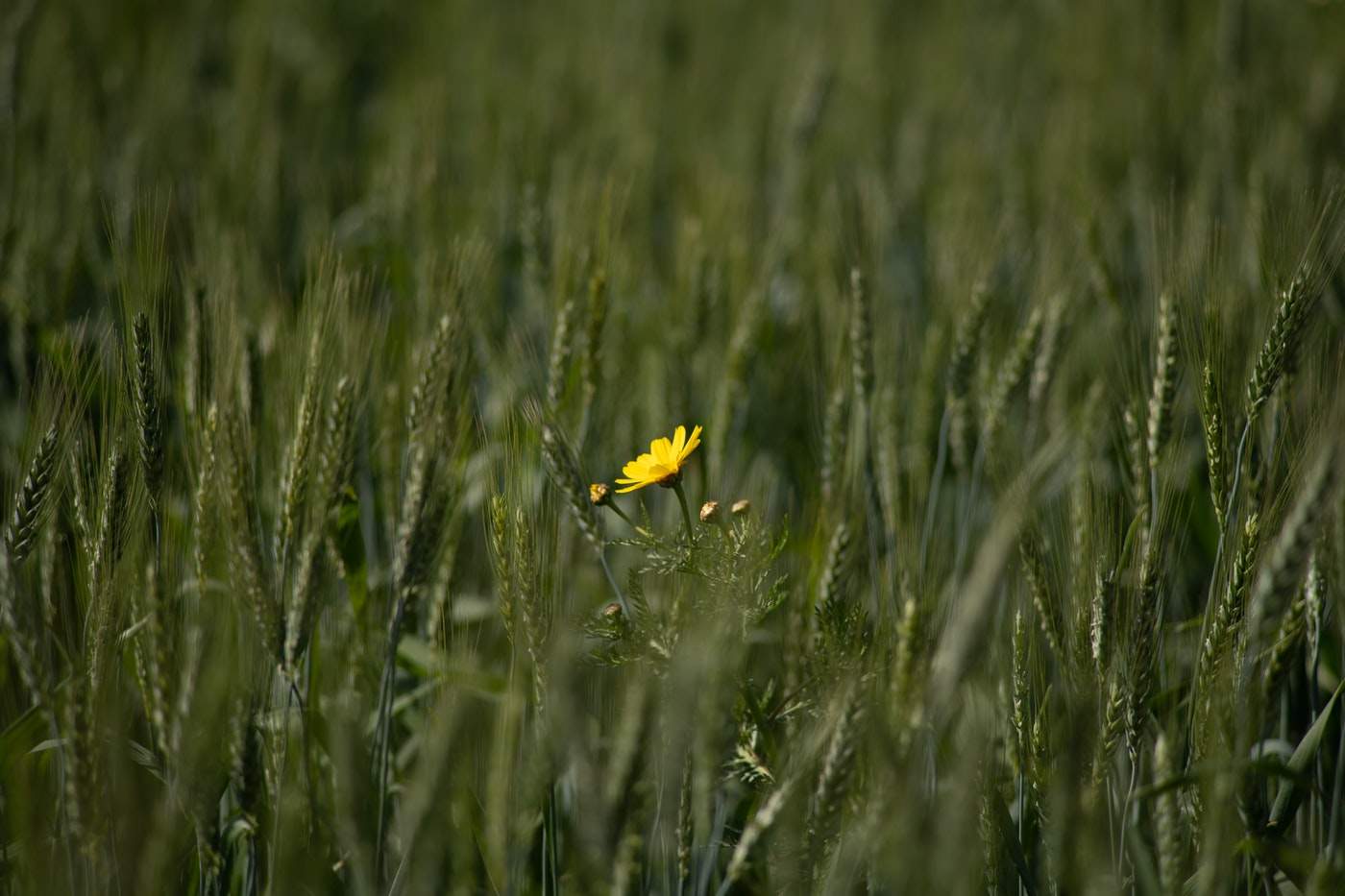Ready to learn about daisies? Then you’re in luck. This post will introduce you to a few different types of yellow daisy flower, along with some tips on how to grow yellow daisies and how to care for yellow daisies.
It will finish by thinking about flower symbolism and trying to get to the bottom of the surprisingly common question: what do yellow daisies mean? Let’s get going.
What Are Yellow Daisies Called?
There’s no one species that’s universally referred to as a yellow daisy, but there are many species of daisy that are, or can be, yellow. There are also many species that are not daisies, but that are called by that name and can also be yellow.
To explain a bit further, daisies like the English daisy (Bellis perennis), the Shasta daisy (Leucanthemum × superbum) and other daisy species belong to the family Asteraceae. Somewhat confusingly, though, some flowers are informally called daisies even though they’re not in that family at all.
Taxonomy can get complicated, but the National Center for Biotechnology Information (NCBI) has this taxonomy database if you’re interested in learning more about the daisy family. For our purposes, we included both flowers that belong to the Asteraceae family and ones that are only informally known as daisies, so we’d have a chance to show you some lesser-known beauties.
Kinds of Yellow Daisies
Yellow daisies come from all over the world. These species are all unique and lovely and we hope this section introduces you to some flowers you may not have heard of before.
Curly Leaf Daisy (Arctotis revoluta)
This woody shrub is native to South Africa. Arctotis is a fast-growing perennial that’s very easy to care for. The shrubs grow from 1-3 feet tall and can grow just as wide. They flower from summer to fall.
Both the leaves and the flowers have different colours underneath—the bright yellow or orange blooms are maroon on their undersides and the leaves are a silver-grey underneath.
Arctotis is simple to grow from cuttings and a bit more hit and miss to grow from seeds. As a coastal plant, it can handle rocky and sandy soils and thrives in many soil conditions, making it perfect for rock gardens and areas where the soil isn’t great.
It’s extremely hardy, with low watering needs. It likes full sun, but isn’t a fan of extreme heat.
Butter Daisy (Melampodium divaricatum)
The butter daisy is another low-maintenance daisy that’s easy to grow and care for. It’s an annual with large, pretty leaves and flowers that can be anywhere from light yellow to orange. Cultivars range from 10 inches to 3 feet with a spread of between 10 and 15 inches. They have a long bloom season, flowering from late spring until the frost.
The plant hails from Central and South America and appreciates full sun and warmth. Grow from seed or purchase as nursery plants. The larger cultivars make wonderful bedding and border plants, while the smaller cultivars are perfect for containers.
Aside from its vibrant flowers, the big attraction of the butter daisy is how little work they are. Establish in well-drained soils and they pretty much take care of themselves. They require little water and are self-branching and self-cleaning. No pinching is required, and you won’t have to learn how to deadhead yellow daisies in order to keep this one thriving. They even resist deer.
Dahlberg Daisy (Thymophylla tenuiloba)
Also known as Dyssodia tenuiloba, golden dogwood and golden fleece, the Dahlberg daisy is a highly lovable addition to the garden. It’s low growing (up to 12 inches tall) and trailing, with delicate, frothy leaves and masses of small, bright yellow flowers that bloom throughout the summer.
While they’re typically grown as an annual in USDA zones 5-11, in warmer places they can be grown as biennials. Since these daisies self-seed, gardeners in warmer regions could find them coming back year after year.
Native to northern Mexico and the southcentral U.S., these are flowers that like hot, dry conditions. Start them from seed and when you move them outdoors, keep them in full sun, ideally in well-draining soil. They prefer less water rather than more, and they can handle a drought.
Dahlberg daisies make an excellent ground cover, although their trailing habit also looks striking in a hanging basket or planter.
Engelmann’s Daisy (Engelmannia peristenia)
This bushy perennial grows to 1.5-2 feet high and is native to the south-central U.S. and northeast Mexico. Its bright yellow flowers bloom in clusters and have somewhere between 8 and 10 petals. The petals will stay shut while the sun is at its hottest, but open when the weather cools in the later afternoon. This daisy’s bloom season can be from March until July.
As a native plant, Engelmann’s Daisy is extremely easy to care for. In the wild it grows in open fields and by roadsides, so it can tolerate a range of soils and some less than ideal growing conditions. It’s hardy in Zones 5-10. It prefers full sun and drier soil. It also prefers low-moderate watering and is an excellent plant for drought-prone areas.
They’re easy to grow from seed. They self-seed readily, so you can let the daisy naturalize into your landscaping or collect seeds in the summer for more control over its growth.
Chocolate Daisy (Berlandiera lyrate)
Chocolate daisies get their name from their foliage, which is said to smell like chocolate. They’re shrub-like perennials native to the southwest and south-central U.S. and to Mexico and are hardy in USDA zones 4-10.
Their golden yellow flowers have dark centres and are big draws for pollinators. The flowers open when the weather is cooler but can droop in the heat. These daisies have a long blooming season, starting in spring and going into November. In warm climates, they can bloom year-round.
Plants grow from 1 to 2 feet high in compact mounds with a wealth of blooms. They’re a perfect addition to naturalized areas, rock gardens, beds and borders.
Chocolate daisies tolerate a range of growing conditions. Plant in part-shade to full sun, ideally in well-drained soil. Their water needs are low and they’re highly drought tolerant. They self-seed easily and are also easy to grow from seed.
Gloriosa Daisy (Rudbeckia hirta)
You might know this flower by its more common name—black-eyed Susan. A staple of the late summer garden, black-eyed Susan is a widespread native of North America, which makes it tough and easy to grow. They’re hardy in Zones 3-9.
Their bright yellow blooms are as popular with pollinators as they are with gardeners and florists. These plants can grow from 1 to 3 feet in height and flower profusely in most growing conditions. Depending on variety, they might be perennials, biennials or annuals. The number of varieties is increasing to include different colours and plant heights.
To grow them, plant black-eyed Susans in full or partial sun. They prefer moist, well-drained soil but can make do in a range of soil conditions. Water them regularly, but not excessively—they can handle drought just fine. They grow easily from seed, although they’re also very easy to find as nursery plants.
Yellow Daisy (Chrysanthemum multicaule)
Chrysanthemum multicaule is sometimes called a yellow daisy for its resemblance to a small Marguerite daisy. This annual is native to northern Africa and can flourish in a variety of growing conditions.
It reaches about 6-12 inches tall, growing in compact mounds with profuse flowers that bloom from summer to autumn. It’s popular in rock gardens, beds, borders and containers, as well as hanging baskets. As a groundcover, its trailing habit livens up walkways with golden blooms that attract pollinators.
This isn’t a terribly picky plant. It tolerates many kinds of soil, as well as a less than regular watering schedule (although less is better than more). It does like its sunlight, so plant in full sun. It also prefers moderate temperatures, so avoid hot afternoon sun if you can. Chrysanthemum multicaule grows well from seed. You can harvest the seeds, as well, and save them for next year.
Daisies That Can Be Yellow
There are a few different kinds of daisies that aren’t necessarily yellow, but that do bloom in that colour. Making sure you get a yellow-flowering plant could be a matter of choosing the right variety or simply choosing a nursery plant that’s the colour you want.
Gerbera Daisy (Gerbera jamesonii)
The gerbera daisy goes by many names: African daisy, Barberton daisy and Transvaal daisy being just a few. Although they’re native to South Africa, cultivars have spread all over the world and are easy to find in nurseries and garden centres.
Gerbera cultivars can vary widely, not just in colour, but in bloom shape and size (some can get up to 5 inches across!), as well as plant size. They can be anywhere from 6-18 inches tall. All are hardy only in USDA zones 8-11.
You can grow them from seed, but you won’t be guaranteed to end up with yellow, so it’s often best to purchase them as nursery plants if you have a specific colour scheme in mind. Plant in well-draining soil in a spot that gets full sun. Experts tend to recommend growing gerberas in containers if your soil is heavy. They need moderate watering but be careful not to overdo it—they’re prone to rot.
Livingstone Daisy (Cleretum bellidiforme)
Another gorgeous flower that originates from South Africa, Livingstone daisies come in a big range of colour that includes yellow. With their dark centres and narrow fringe of petals, they add a unique spot of summer colour to beds and borders.
If you live in Zones 10-11, you can enjoy them as perennials; otherwise, they’re grown as annuals. Livingstone daisies make excellent ground covers and thrive in rock gardens and areas where other annuals struggle. These low-growing succulents can reach from 4 to 10 inches tall.
They close their flowers are night and on very cloudy days, but open when the sun comes out, so grow these beauties in full sun so you can enjoy them to the fullest.
Be careful not to overwater them—they can be prone to rotting when kept too moist. They can tolerate a range of soils, although their preference is for well-draining living quarters. They’re simple to grow from cuttings or seed and will self-seed readily.
Marguerite Daisy (Argyranthemum frutescens)
Native to the Canary Islands, Marguerite daisies have the petal shape of a classic daisy, but come in hues of yellow, pinks and purples in addition to white. Varieties that are specifically yellow include “Golden Butterfly,” “Madeira Primrose” and “Spring Bouquet,” whose flowers start pink and turn yellow and white.
Fantastic for pollinators, these short-lived perennials are easy to care for specimens that, unlike many daisy varieties, bloom in the cooler weather of spring and fall. They grow 1 to 3 feet high and are bushy plants that can reach 3 feet wide, making them perfect for garden beds that need some filling in.
The easiest way to grow Marguerite daisies is to purchase as a nursery plant or to take cuttings because the seeds won’t grow true to the parent plant. Plant them in partial to full sun. They prefer well-draining soil and moderate watering. Be sure to deadhead to prolong the flowering season.
Crown Daisy (Glebionis coronaria)
Crown daisies are native to the Mediterranean but cultivated in East Asia as an ornamental plant and also as a cooking green. The greens are very healthy, with high vitamin and mineral content and a slightly bitter taste.
These annuals can grow anywhere from 8 inches to 4 feet tall, depending on the variety. Again depending on variety, their flowers can be entirely yellow, but they can also be white with a charming ring of yellow on the inner edges of the petals and a yellow centre. Spring bloomers, they’re hardy in USDA zones 5-9.
Grow crown daisies in full sun, preferably in rich, well-drained soil. Their watering needs are average, although they also tolerate droughts well. They grow easily from seed. One thing to note is that they’re assertive spreaders, so some thinning work might be necessary. At least in this case you can eat the plants you thin out, so you’ll have a reward for your labours.
Daisy Chrysanthemums (Chrysanthemum x morifolium)
Chrysanthemums can be real chameleons of the flower world, with different varieties looking like entirely different species. Daisy mums have a classic daisy appearance, although they come in many more shades than actual daisies. For yellow daisy mums, try “Amber Morning,” “Chrysanthemum Daisy Gold” and “Hankie Yellow.”
Like other kinds of chrysanthemums, daisy mums flower in the fall and will keep flowering until the frost. These perennials are hardy in zones 5-9 and otherwise are grown as annuals. They can reach 1-3 feet in height and grow quite wide, making them perfect for filling out a garden bed with some late-season colour.
Daisy mums share the chrysanthemum’s easy-going nature. Plant daisy mums in full sun and well-drained soil for best results. Water regularly to keep these mums evenly moist but not wet. They like a rich soil but can get by in less than ideal growing conditions, too. Purchase as nursery plants.
What Do Yellow Daisies Symbolize?
Since the Victorian period, people have been deeply intrigued by the meanings of flowers. Daisies have symbolized many things over the centuries, from new days and fresh starts to bereavement to young love to childhood. Ian Morton’s fascinating piece for Country Life leads us through the history of daisy symbolism and is well worth a read.
That history, however, applies to the English daisy. What do yellow daisies represent, specifically? Well, people associate yellow with cheerfulness, positivity and friendships, so you can imagine yellow daisies’ meaning to be in line with that general symbolism. It’s important to remember that as cultures, we make our symbols as we go, so you can add on the meanings you like. History is not the boss of you.
Feature image: Enrique; Image 1: Syarif Moh; Image 2: Tina Nord; Image 3: aner tau



